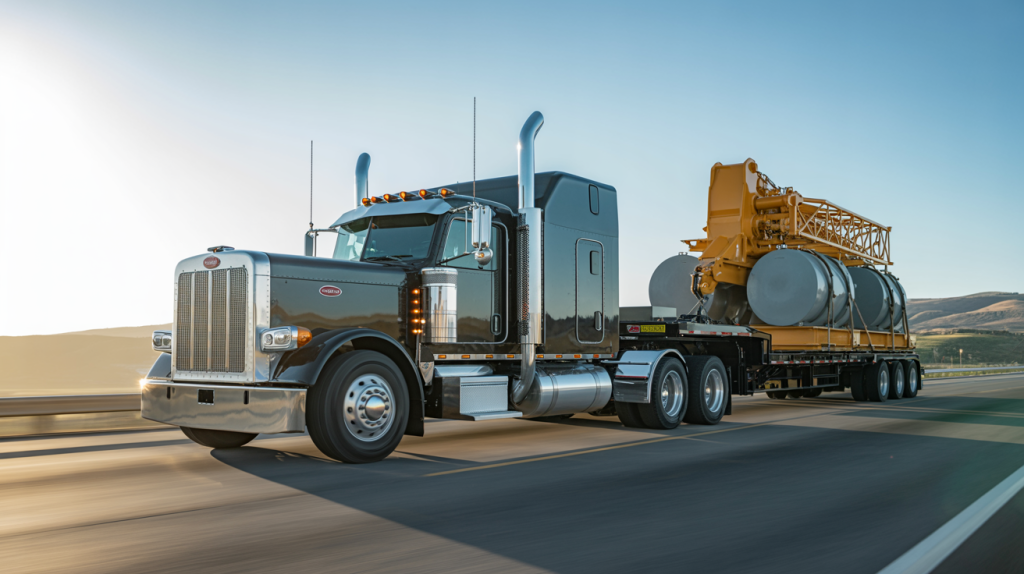Safe Heavy Haul Route Planning in North Dakota During Winter – Here’s What We Do
Freedom Heavy Haul can offer expedited Pickup and Delivery for any size shipment anywhere in the USA. Contact us today for No Hassle, No Pressure Pricing.
We at Freedom Heavy Haul plan for ice roads, seasonal permits, specialized gear, and real-time data to keep our heavy haul operations safe and compliant in North Dakota’s winter conditions.
In this article, you will learn about Safe Heavy Haul Route Planning in North Dakota During Winter, and how we manage the route planning.
Heavy Haul Operations in North Dakota
Understanding Our Cargo and Terrain
When we haul oversized loads in North Dakota—such as wind turbine blades, drilling rigs, or large storage tanks—we must:
- Account for limited infrastructure
- Service stations, fuel stops, and safe turnaround points are sparse in remote areas.
- Navigate challenging terrain
- Open plains and badlands hide weak bridges and narrow corridors that cannot support our loads.
- Choose the right trailer configuration
- Multi-axle trailers or RGN (removable gooseneck) units distribute weight properly.
- Jeep/dolly setups help break large loads into manageable segments.
How We Manage Constraints
- We at Freedom Heavy Haul pre-map weak bridges and clearance restrictions using GIS.
- We schedule stops at verified refueling points, ensuring our trucks never run low on diesel or DEF.
- We train our drivers to recognize ice patches on flat plains where black ice forms quickly.
Winter Road Safety and Mitigation
Recognizing Environmental Hazards
Winter in North Dakota means we face:
- Icy road surfaces
- Black ice can appear without warning, increasing stopping distances.
- Blizzard conditions
- Visibility can drop to near zero, forcing reduced speeds or stops.
- Subzero temperatures
- Engines can seize, and hydraulics can freeze if we’re not prepared.

How We Adapt Our Vehicles
- Tire and traction solutions
- We at Freedom Heavy Haul equip trucks with studded or deep-tread winter tires matched to our axle loads.
- Automatic chain-deployment systems allow us to add traction without stopping.
- Cold-weather mechanical systems
- Block heaters keep our engine oil and coolant at optimal temperatures for morning starts.
- We use cold-rated lubricants and brake fluids designed to flow at -20°F or lower.
- Cabin and driver comfort
- Auxiliary diesel heaters maintain a warm sleeper cabin during rest breaks.
- Insulated bunks and arctic-rated sleeping bags ensure drivers stay safe if stranded.
How We Adjust Driver Protocols
- We enforce reduced speeds on untreated highways.
- We conduct pre-trip inspections focusing on lights, brakes, and heating systems.
- We schedule frequent rest stops to check tire conditions and driver alertness.
Ice Roads: Access, Monitoring, and Load Limits
When We Use Ice Roads
Between December and March, some remote locations in North Dakota are only reachable via ice roads:
- Ice road formation
- Frozen lakes, rivers, or permafrost layers become temporary roadways.
- Local authorities measure ice thickness daily before opening a route.
- Monitoring procedures
- We review posted weight ratings at entry points—if we exceed them, we risk cracking the ice.
- We follow speed limits (often 10–15 mph) and maintain minimum truck spacing (e.g., 200 ft).
- Permit considerations
- In addition to our oversize/overweight permit, some ice roads require a specific endorsement or permit.
- We confirm with local agencies to ensure we hold all necessary documentation.
How We Ensure Load Safety on Ice
- We carry flotation devices and cold-water survival gear in case of ice failure.
- We install onboard weight sensors to verify we stay within posted limits.
- We maintain daily check-in calls: if ice conditions change overnight, we reroute before departure.
Legal Framework and Seasonal Permitting
Securing Our Permits
- Oversize/Overweight Permits from NDDOT
- These specify authorized dimensions, weight, mandated travel windows, and required escorts.
- Frost Laws and Thaw Restrictions
- When freeze-thaw cycles begin (usually late February or early March), roads become soft.
- We reduce our gross vehicle weight (GVW) to 75% of allowable loads on affected roads.
- County and township roads often enforce these restrictions on different schedules, so we verify local enactment dates.
- Permit Validity and Updates
- We monitor ND 511 alerts, which notify us of frost-law activations, bridge weight limits, and closures.
- If weather warms unexpectedly, we pause trips until conditions improve—noncompliance risks fines or being forced off the road.
How We Stay Compliant
- We submit permit applications at least 7–10 days in advance to allow for route approvals and adjustments.
- We assign a dedicated compliance coordinator to track permit expirations and seasonal restrictions.
- We maintain a digital folder of all permits (state, county, and ice-road endorsements) for in-cab verification.
Equipment Requirements for Winter Hauling
Trailer and Chassis Upgrades
- Multi-axle trailers or RGN configurations help distribute weight more evenly across fragile surfaces.
- Hydraulic steering axles let us maneuver in tight, icy corridors.
- Reinforced flooring and deck coatings resist ice buildup under the cargo.

Cold-Weather Mechanical Systems
- Engine block heaters keep oil and coolant from thickening before startup.
- Cold-rated lubricants and brake fluids prevent seizing in subzero temperatures.
- Winterized fuel filters stop diesel wax formation, ensuring fuel flows smoothly.
How We Equip Cabins for Safety
- Auxiliary heaters powered by diesel feed heat to the sleeper without idling the engine.
- Insulated curtains and heavy-duty mattress pads trap heat and guard against wind chills.
- High-capacity batteries and block heater timers ensure quick restarts—no surprises after a long layover.
Mapping and Monitoring Tools for Route Selection
Real-Time Data Integration
- Geographic Information Systems (GIS)
- We overlay frost-law maps, bridge weight limits, and low-clearance points to plan our corridors.
- Telematics and Live Weather Feeds
- Telematics units in our trucks provide real-time alerts on wind chill, precipitation, and road surface temperatures.
- Meteorological APIs feed live radar data to our dispatch team, predicting blizzard paths and whiteout zones.
- North Dakota 511 System
- We subscribe to automated text and email alerts for updates on highway closures or icing warnings.
- ND 511 notes seasonal closures of mountain passes and weight-restricted bridges—information we reference before departure.
How We Optimize Routes
- We at Freedom Heavy Haul run route optimization software that balances distance, permit constraints, and weather conditions.
- If a primary corridor closes mid-trip, we have pre-approved alternates ready, often bypassing ice-covered segments.
- We schedule weekly check-ins with NDDOT’s operations center to catch early frost-law changes.
State and Local Coordination for Route Management
Engaging with Authorities
- North Dakota Department of Transportation (NDDOT)
- We contact NDDOT to get permit approvals and confirm frost-law activation dates.
- They provide weekly advisories throughout freeze-thaw transitions.
- North Dakota Highway Patrol (NDHP)
- NDHP assigns escorts for superloads and enforces speed and safety regulations.
- They coordinate with NDDOT to close roads proactively when conditions worsen.
- County and Tribal Jurisdictions
- Each county may enact frost laws on slightly different dates—so we verify with each county highway department.
- If our route traverses tribal lands, we call the tribal transportation office 48–72 hours before hauling to confirm rules.

How We Maintain Communication
- We at Freedom Heavy Haul establish a weekly liaison schedule with NDDOT, NDHP, and county/tribal authorities whenever we have recurring routes.
- We keep a centralized route folder in our fleet management system, updating permit PDFs and contact logs.
- If new frost-law restrictions surface, we adjust our schedule immediately and notify our drivers with precise instructions.
Emergency Planning and Risk Control
Preparing for the Unexpected
- Essential emergency supplies in every truck:
- Arctic-rated sleeping bags and insulated blankets for overnight survival.
- A 72-hour supply of shelf-stable food, water, and high-calorie snacks.
- Backup communications—satellite phone or two-way radios—because cell service may vanish.
- Traction aids: portable chains, ice scrapers, and sandbags.
- Driver training and protocols:
- We train every driver on snow-and-ice driving techniques, focusing on snap-acceleration recovery and skid control.
- Each driver receives personal locator beacons with instructions on when and how to activate them.
- We enforce mandatory check-in intervals: if a driver misses a check, our dispatch team initiates the emergency plan.
How We Execute Contingency Plans
- We at Freedom Heavy Haul identify secondary corridors ahead of time that remain open under frost laws or bypass ice-road segments.
- We contract with recovery services located within 100 miles of primary and alternate routes.
- If a breakdown or road closure occurs, we switch to our pre-approved alternate route and dispatch a support vehicle if needed.
How It All Connects: Our Comprehensive Winter Logistics Strategy
- Plan Early and Communicate Frequently
- We submit permits at least 7–10 days in advance.
- We hold weekly check-ins with NDDOT, NDHP, and local jurisdictions.
- Leverage Technology
- We at Freedom Heavy Haul overlay GIS data, telematics feeds, and ND 511 alerts to refine our route in real time.
- We install onboard sensors for ice-thickness verification when using ice roads.
- Optimize Equipment for Subzero Conditions
- We outfit trucks with block heaters, cold-rated fluids, and specialized winter tires.
- We maintain a preventative maintenance schedule focused on heating, ignition, and hydraulics.
- Maintain Compliance at Every Step
- We track frost-law dates for each county to avoid penalties or forced stops.
- We keep digital copies of all permits and endorsements in our fleet management portal.
- Prepare for Emergencies
- We equip drivers with arctic gear, emergency rations, and backup communications.
- Our dispatch team has secondary routes and recovery contacts ready before departure.
By uniting these elements—seasonal permits, specialized gear, real-time data, and robust emergency planning—we keep our heavy haul operations moving safely and on schedule, even in North Dakota’s harshest winter conditions.
FAQ about Heavy Haul Route Planning in North Dakota
Q1: How do we know when ice roads are safe to use?
We rely on daily ice-thickness measurements performed by certified inspectors or local road crews. Entry points display posted weight ratings—if our load measures below the recommended limit (often 25–40 tons per axle), we proceed. Otherwise, we wait or reroute.
Q2: When do frost laws apply in North Dakota, and how do we adjust?
Frost laws usually activate between late February and early March, depending on local weather. We monitor ND 511 advisories and county highway department announcements. Once active, we reduce GVW to 75% of normal weight on affected roads and adjust our load plans accordingly.
Q3: Do we need a separate permit for winter hauling versus summer?
Yes. In addition to our standard oversize/overweight permit, ice roads often require a specific endorsement. We verify with NDDOT and local agencies to ensure all permits (including ice-road approvals) are in place before departure.
Q4: What emergency gear must our trucks carry in winter?
Our trucks always carry:
- Arctic-rated sleeping bags and insulated blankets
- 72 hours of shelf-stable food and water
- Portable snow chains, scrapers, and sandbags
- Satellite phone or two-way radios
- Personal locator beacons (PLBs)
- A portable diesel-fired heater for cabin warmth
Q5: How do we coordinate with multiple jurisdictions for a single route?
We assign a compliance coordinator to:
- Submit permit applications to NDDOT at least 7–10 days ahead.
- Call each county or tribal authority 48–72 hours before passing through.
- Schedule weekly check-ins during freeze-thaw transitions.







